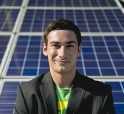As part of our involvement in the City Energy Project, IMT will regularly post updates from local partners about their progress in boosting the efficiency of buildings. Keep checking The Current for news, case studies, and emerging best practices from around the country.

The State of Florida is in a vulnerable position when it comes to climate impacts, and often times lags behind in taking a proactive stance to mitigation and adaptation efforts. To put things in perspective, Florida has been declared a disaster area 19 times since 2000, due to damage from hurricanes, storm surges, heavy rains, and flooding. In 2011 alone, Florida experienced record heat in 20 counties that broke a total of 34 heat records; record rainfall in 22 counties that broke a total of 27 rainfall records; and extreme drought.
 On August 13, Orlando Mayor Buddy Dyer hosted the Climate & Energy Summit, bringing together global and national experts in climate action to discuss best practices and solutions to support economic growth and a sustainable energy future for the City of Orlando, the Central Florida region, and the State of Florida.
On August 13, Orlando Mayor Buddy Dyer hosted the Climate & Energy Summit, bringing together global and national experts in climate action to discuss best practices and solutions to support economic growth and a sustainable energy future for the City of Orlando, the Central Florida region, and the State of Florida.
More than 200 community, business, nonprofit, and public sector executives from across Florida attended the day-long event to learn and discuss how they can join with businesses and governments to achieve positive results from employing the latest innovative technologies and strategies in climate action and sustainable energy.
“We want to be the most sustainable community in the whole southeastern United States,” Mayor Dyer said during a speech in which he shared several successes achieved through the Green Works Orlando plan, such as the reduction of greenhouse gas emissions from municipal operations by over 15 percent from 2007 levels, and the launch of the SunRail commuter train down the 1-4 corridor.
Mayor Dyer also spoke about Orlando’s leadership in municipal energy efficiency that continues to show significant savings and positive results. With a relatively small $1 million investment—money that came from federal funding under the American Recovery and Reinvestment Act—Orlando improved the energy efficiency of 28 municipal buildings by installing building automation and controls, providing LED lighting upgrades, renovating HVAC systems, and installing smart plug-load devices. These investments are reducing Orlando’s energy bills by an average of 31 percent a year from the 2010 baseline, and showcasing how businesses in the community can also take advantage of cost-effective energy efficiency investments that reduce operating cost with significant returns.
U.S. Senator Bill Nelson was also in attendance to underscore the importance of participation in climate action, and to praise the steps that Orlando has taken to address climate change. “We can celebrate that Orlando is doing its part,” he remarked. “ Little incremental progress is what is ultimately going to make a difference.”

Senator Bill Nelson with Mayor Buddy Dyer at Orlando’s Climate & Energy Summit
He was joined by a roster of speakers that included Mike Boots, Acting Chair of the White House Council on Environmental Quality; Natural Resources Defense Council Executive Director Peter Lehner; Senior Energy Economist and Fellow Dr. John ‘Skip’ Laitner from American Council for an Energy-Efficient Economy (ACEEE); CEO John Porter from Clean Footprint; Commissioner Maylen Dominguez from Orlando Utilities Commission (OUC); CEO Robbie Diamond from Securing America’s Future Energy (SAFE); and Executive Director Jim Fenton from Florida Solar Energy Center (FSEC).
However, the day wasn’t only about celebrating successes—it was also about the path ahead. In hosting the Summit, Mayor Dyer not only reinforced his commitment to programs such as Green Works Orlando and initiatives that foster community participation in reaching to goal of making the City of Orlando one of the most environmentally friendly, economically and social vibrant communities in the nation.
“The recent national climate assessment makes it clear that the Southeast, and particularly Florida, may face higher temperatures, increased storm intensity, sea level rise, and other threats that will challenge our economy and our way of life,” he said. “I want to make sure that we understand that these challenges are actually opportunities.”
To that end, Mayor Dyer went on to detail future initiatives that will respond to climate concerns while creating a better quality of life and economic growth in Orlando. Specifically, the City plans to increase its commitment to solar energy, explore waste solutions that produce energy, decrease dependence on foreign oil, pass energy efficiency and green building policies, and increase the tree canopy of the city to a 40-percent tree cover.
Orlando’s participation in the City Energy Project, which was recognized during the summit by both Mayor Dyer and NRDC’s Peter Lehner, as a framework of tangible strategies that cities can begin developing to drive energy efficiency in buildings and spur a clean energy industry for the region. This work is still in the development phase, but it has the potential to significantly slash energy waste, create jobs, cut emissions, and save Orlando consumers an estimated $55 million a year on energy.
This national initiative allows us to tap the true potential of the programs and initiatives under in Orlando to not only improve our path ahead on the local level, but to also contribute to a greater framework for cities and counties throughout the U.S.
*Click here to see more photos from the event.
